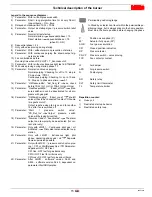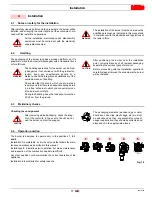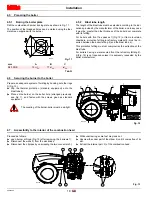
Maintenance
29
20035606
GB
6.1
Notes on safety for the maintenance
The periodic maintenance is essential for the good operation, safe-
ty, yield and duration of the burner.
It allows you to reduce consumption and polluting emissions and to
keep the product in a reliable state over time.
Before carrying out any maintenance, cleaning or checking opera-
tions:
6.2
Maintenance programme
6.2.1
Maintenance frequency
The combustion system should be checked at least once a year by
a representative of the manufacturer or another specialised techni-
cian.
6.2.2
Checking and cleaning
Combustion
The optimum calibration of the burner requires an analysis of the
flue gases. Significant differences with respect to the previous
measurements indicate the points where more care should be ex-
ercised during maintenance.
Combustion head
Open the burner and make sure that all components of the com-
bustion head are in good condition, not deformed by the high
temperatures, free of impurities from the surroundings and cor-
rectly positioned.
Fan
Check to make sure that no dust has accumulated inside the fan or
on its blades, as this condition will cause a reduction in the air flow
rate and provoke polluting combustion.
Boiler
Clean the boiler as indicated in its accompanying instructions in or-
der to maintain all the original combustion characteristics intact, es-
pecially the flue gas temperature and combustion chamber
pressure.
Filters
Check the filtering baskets on line and at nozzle present in the sys-
tem.
Clean or replace if necessary.
If rust or other impurities are observed inside the pump, use a sep-
arate pump to lift any water and other impurities that may have de-
posited on the bottom of the tank.
Nozzles
It is advisable to replace nozzles every year during regular main-
tenance operations.
Do not clean the nozzle openings; do not even open them.
Flexible hoses
Check to make sure that the flexible hoses are still in good condi-
tion.
Power to photocell QRI
(Fig. 33)
Min value for a good work: 3.5 Vdc (AZL display flame approx.
50%).
If the value is lower, it can depend on:
–
photocell positioned incorrectly;
–
low current (lower than 187 V)
–
bad regulation of the burner.
To measure power, use a voltmeter with a 10 Vdc scale, connected
as illustrated on Fig. 33.
Fuel tank
Approximately every 5 years, or whenever necessary, suck any
water or other impurities present on the bottom of the tank using a
separate pump.
Combustion
In case the combustion values found at the beginning of the inter-
vention do not respect the standards in force or, in any case, do not
correspond to a proper combustion, contact the Technical Assist-
ant and have him carry out the necessary adjustments.
6
Maintenance
DANGER
The maintenance interventions and the calibration
of the burner must only be carried out by qualified,
authorised personnel, in accordance with the con-
tents of this manual and in compliance with the
standards and regulations of current laws.
DANGER
Disconnect the electricity supply from the burner by
means of the main switch of the system.
DANGER
Close the fuel interception tap.
0...10 V
Ri > 10 M
:
X10-02 / 6
X10-02 / 4
X10-02 / 2
LMV...
+
D9174
Fig. 33
Summary of Contents for RL 300
Page 2: ......
Page 33: ...Appendix Spare parts 31 20035606 GB A Appendix Spare parts ...
Page 38: ...20035606 36 GB Appendix Electrical panel layout ...
Page 39: ...Appendix Electrical panel layout 37 20035606 GB ...
Page 41: ...Appendix Electrical panel layout 39 20035606 GB ...
Page 42: ...20035606 40 GB Appendix Electrical panel layout ...
Page 43: ...Appendix Electrical panel layout 41 20035606 GB 0 1 0 ...
Page 44: ...20035606 42 GB Appendix Electrical panel layout 0 0 0 1 0 2 0 0 0 0 0 0 0 30 3 3 0 0 1 0 ...






























